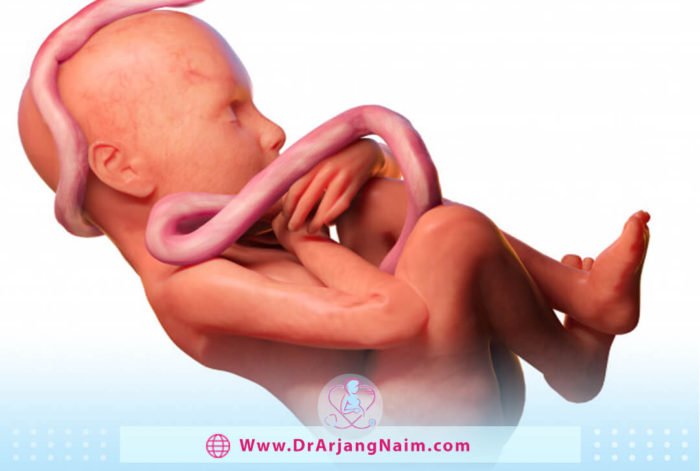The position of the placenta in front of the uterus and toward the mother’s abdomen is called the anterior placenta. It is an organ that helps the baby grow, attaches to the uterus wall, and attaches to the baby through the umbilical cord. The placenta carries oxygen, nutrients, and antibodies from the mother’s blood to the baby، it also carries waste products from the baby to the mother’s blood, fights internal infections, and helps produce hormones to protect the pregnancy.
The placenta is embedded in the wall of the uterus and is located above, below, or around the uterus. But the pair’s placement is not always the case; sometimes, things are slightly different.
The anterior placenta forms when the fetus is in the anterior wall of the uterus. Fertilized eggs usually implant in the back of the uterus, which is close to the spine. But in some cases, the egg is implanted on the opposite side, the front wall of the uterus, and close to the abdomen. In this case, the placenta grows before the uterus, and the fetus is behind it.
Placental location
Anterior placenta placement is relatively common and not a cause for concern. Often, the placenta grows wherever the fertilized egg is implanted, so it grows anywhere in the uterus. Places where the placenta can be placed, include:
- Anterior: The front of the uterus to the front of the body and stomach
- Fundal: The top of the uterus
- Lateral: The right or left side of the uterus
- Low-lying: At the bottom of the uterus, sometimes covering the cervix
- Posterior: The back of the uterus to the spine and the back of the body
The most common site of implantation and placenta is upward and behind the uterus. It is unclear why the placenta grows in different places, but because it is often located behind the uterus, it is accessible to areas rich in blood vessels.
Does the anterior placenta affect pregnancy?
In general, the position of the placenta has no effect on pregnancy or the fetus unless the placenta blocks the cervix, which is called the placenta previa. A woman with placenta previa may need to be hospitalized and have a cesarean section. Due to the position of the placenta in front of the baby, a woman with an anterior placenta may not feel as much fetal movement as a woman with a posterior placenta, especially early in pregnancy when the fetus is smaller.
The sensation of kicking a baby can be felt from the early 18 weeks. This may happen a little earlier for people who have already given birth. Diagnosing these movements often takes longer for mothers pregnant for the first time and those with an anterior placenta.
There is an anterior pair, like an extra layer between the baby and the outer wall of the abdomen. This cushioning may make it harder to feel the baby kicking until the third trimester of pregnancy when it is big enough to make more noticeable movements.
In cases where a woman needs amniocentesis, the anterior placenta may make the test a little more difficult for the doctor.
Diagnosis

The obstetrician can see the position of the placenta during the ultrasound. The doctor will check the placenta if an ultrasound scan or second-level anatomy is done at about 20 weeks in the middle of pregnancy. If you have an ultrasound early in pregnancy, you may learn about the anterior placenta sooner.
However, having an anterior placenta on early ultrasound does not mean that the placenta will remain there. It is very common to change the position of the placenta by stretching and growing the uterus. The anterior placenta can migrate upward to the sides or the back of the uterus over weeks.
Precautions to take while having an anterior placenta
Some precautions can be taken when the placenta is in the anterior.
Eating well
A well-nourished Placenta is a healthy Placenta.
Staying hydrated
The placenta needs fluids to process all the waste products of the developing fetus.
Having an exercise plan
Having a regular exercise program according to the pregnancy conditions and stretching exercises can benefit the placenta and the fetus.
Making good lifestyle choices
Stress, overwork, alcohol, drugs, and eating too much or too little can put the pregnancy at risk.
When to call a doctor
Once the doctor confirms that he has an anterior placenta, be vigilant and watch for vital signs and symptoms that could indicate a complication. Be sure to call the doctor if you have any of the following symptoms:
- Vaginal bleeding
- Unusual abdominal Pain
- Uterine contractions
- Severe lower back pain
- Decreased fetal movement
- Firmness in the uterus
Complications
Although the anterior placenta is usually not a cause for concern, it may affect the pregnancy outcome. Women with the anterior placenta may be at risk for the following complications:
- Pregnancy-induced hypertension
- Intrauterine growth restriction
- Gestational diabetes
- Placental abruption
- Intrauterine fetal death
Labor

In most cases, having an anterior placenta will not affect labor. As long as the placenta is not low, there is no need to worry; there is a possibility of vaginal delivery. However, cesarean delivery may be recommended for these people due to severe back pain during normal delivery.
If the delivery is by cesarean section, and the placenta is low and covers the cervix, the risk of bleeding may increase. For this reason, the placenta may be in the same place where the surgeon should make the incision to deliver the baby. In these cases, it is possible to higher up than usual to reduce the risk of bleeding. An ultrasound scan is done to help the surgeon determine the best position to make the incision.
If the placenta is low on a 20-week scan, a re-scan will be done at 32 to 36 weeks to check if the placenta has moved up and out of the uterus. The placenta usually moves upward as the uterus expands around the growing baby.
The bottom line
Anterior placenta occurs when the placenta grows in front of the uterine wall. This is usually not a concern and often does not affect the outcome or management of the pregnancy. However, it may make it more difficult for women to feel fetal movements or find a fetal heartbeat.
A woman should consult her doctor about any concerns about pregnancy or signs of placental problems. Dr. Arjang Naim, MD, monitors the baby’s placement and the placenta during pregnancy. Regular prenatal care and managing conditions that may arise during pregnancy can help you give birth to a healthy baby.
Additional questions
- Which is the best placenta position?
Women with an anterior placenta have the highest risk of placental abruption, and women with a posterior placenta have the lowest risk of placental abruption.
- What happens if the placenta bleeds?
Placental abruption occurs when the placenta separates from the inner wall of the uterus before birth. Placental separation can deprive the baby of oxygen and nutrients and cause heavy bleeding in the mother. In some cases, premature delivery is necessary.
- What causes intrauterine fetal death?
There are many reasons for stillbirth, the most important:
- Intrapartum complications
- Hypertension
- Diabetes
- Infection
- Congenital and genetic abnormalities
- Placental dysfunction
- Pregnancy continuing beyond forty weeks
- What are the benefits of the anterior placenta?
The placenta in front of the baby acts like a cushion or shield between the growing baby and the belly, making the baby’s movements seem softer.
- What can damage the placenta?
- Substance use (some placental problems are more common in women who smoke or use cocaine during pregnancy).
- Abdominal trauma (abdominal trauma, such as a fall, accident, or other types of trauma, increases the risk of placental abruption).
References
https://parenting.firstcry.com/articles/anterior-placenta-during-pregnancy-all-you-need-to-know/
https://www.whattoexpect.com/pregnancy/ask-heidi/anterior-placenta.aspx
https://www.babycentre.co.uk/x566457/is-having-an-anterior-placenta-a-problem
https://www.kickscount.org.uk/anterior-placenta
https://www.bounty.com/pregnancy-and-birth/pregnancy/pregnancy-other-conditions/anterior-placenta
https://www.verywellfamily.com/what-it-means-to-have-an-anterior-placenta-4690878
https://www.medicalnewstoday.com/articles/324554




